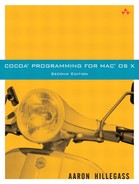When I teach a class, it always ends with the “Feel-Good Talk,” which delivers the following messages:
The knowledge you have received from this experience never comes easy. You have learned a lot of stuff. Be proud.
The only way to solidify what you have learned is to write applications. The sooner you start, the easier it will be.
There is still much more to learn, but you have crossed the hump in the learning curve. Matters will be easier from here. Once again, the only way to progress is to write applications.
As a speaker, I'm available for weddings, parties, bar mitzvahs, and other events. I also offer five-day classes at the Big Nerd Ranch. For a schedule, please see the Big Nerd Ranch Web site
(http://www.bignerdranch.com).
The final part of the “Feel-Good Talk” is a listing of resources that will help answer your questions as they arise. As with any programming topic, your answers will be found in a hodgepodge of online documentation, Web sites, and mailing lists.
If you have a question about Cocoa, the first place to check is in the reference documentation. All of the classes, protocols, functions, and constants are listed there. Look in
/Developer/Documentation/Cocoa/Reference/.If you have a question about Objective-C, the first place to check is in the Objective-C reference documentation. Look in
/Developer/ Documentation/Cocoa/ObjectiveC/.If you have a question about Xcode or Interface Builder, the first place to check is in the developer tools reference documentation. Look in
/Developer/Documentation/DeveloperTools/.Mark Dalrymple and I wrote a book on the plumbing of Mac OS X from a developer's point of view. If your code is going to do anything with the operating system (like multithreading or networking), I strongly recommend that you pick up a copy of Core Mac OS X and Unix Programming.
Don't be afraid to experiment—most questions can actually be answered by creating a tiny application. Creating this application will probably take you less than 15 minutes.
The Web site for this book (http://www.bignerdranch.com/Book) has the answers to many questions and several fun examples.
Two Web sites are frequented by Mac OS X developers: StepWise (http://www.stepwise.com/) and CocoaDev Wiki (http://www.cocoadev.com/).
You can search the archives of the MacOSX-dev mailing list at the OmniGroup Web site (http://www.omnigroup.com/). It is a very active mailing list, and searching it can be rather tedious. Apple also has a mailing list for Cocoa developers. You can join the cocoa-dev mailing list at Apple's list server (http://lists.apple.com/). Both lists are archived at http://www.cocoabuilder.com/.
If you have exhausted all other possibilities, Apple's Developer Technical Support will answer your questions for a fee. The folks there have answered lots of questions for me, and I find them to be consistently knowledgeable and helpful.
Join the Apple Developer Connection. It will give you access to the latest developer tools and documentation. The ADC Web site is http://connect.apple.com/.
Finally, try to be nice. Help beginners. Give away useful applications and their source code. Answer questions in a kind manner. It is a relatively small community, and few good deeds go forever unrewarded.
Thanks for reading my book!
